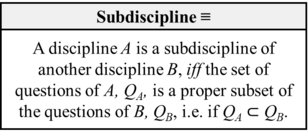Difference between revisions of "Subdiscipline (Patton-Al-Zayadi-2021)"
Paul Patton (talk | contribs) |
Paul Patton (talk | contribs) |
||
| Line 6: | Line 6: | ||
|Authors List=Cyrus Al-Zayadi, Paul Patton | |Authors List=Cyrus Al-Zayadi, Paul Patton | ||
|Formulated Year=2021 | |Formulated Year=2021 | ||
| − | |Description=A more specialized [[Discipline| discipline]] ''A'' is a subdiscipline of another, more general discipline ''B'', if and only if the set of [[Question| questions]] ''Q<sub>A</sub>'' of ''A'' is a proper subset of the questions ''Q<sub>B</sub>''of ''B'' [[Patton and Al-Zayadi (2021)]]. For example, cellular neurobiology, the discipline which deals with the cellular properties of nerve cells, is a subdiscipline of neuroscience, which deals with the properties and functions of nervous systems. | + | |Description=A more specialized [[Discipline| discipline]] ''A'' is a subdiscipline of another, more general discipline ''B'', if and only if the set of [[Question| questions]] ''Q<sub>A</sub>'' of ''A'' is a proper subset of the questions ''Q<sub>B</sub>''of ''B'' [[CiteRef::Patton and Al-Zayadi (2021)]]. For example, cellular neurobiology, the discipline which deals with the cellular properties of nerve cells, is a subdiscipline of neuroscience, which deals with the properties and functions of nervous systems. |
The [[Scientific Mosaic|scientific mosaic]] consists of [[Theory|theories]] and [[Question|questions]].[[CiteRef::Barseghyan (2015)]][[CiteRef::Barseghyan (2018)]][[CiteRef::Rawleigh (2018)]][[CiteRef::Sebastien (2016)]] As a whole, a discipline ''A'' consists of a set of accepted questions ''Q<sub>A</sub>'' and the theories which provide answers to those questions, or which those questions presuppose.[[CiteRef::Patton and Al-Zayadi (2021)]] Questions form hierarchies, with more specific questions being [[Subquestion| subquestions]] of more general questions. Theories find a place in these heirarchies, since each theory is an attempt to answer a certain question, and each question presupposes certain theories. It is sometimes the case that the questions ''Q<sub>B</sub>''of a broader discipline ''B'' can include all of the questions, ''Q<sub>A</sub>'', of ''A'' as subquestions, with the questions of ''A'', formimg a proper subset of the questions of ''B''. In this situation, ''A'' is then said to be a subdiscipline of ''B''. | The [[Scientific Mosaic|scientific mosaic]] consists of [[Theory|theories]] and [[Question|questions]].[[CiteRef::Barseghyan (2015)]][[CiteRef::Barseghyan (2018)]][[CiteRef::Rawleigh (2018)]][[CiteRef::Sebastien (2016)]] As a whole, a discipline ''A'' consists of a set of accepted questions ''Q<sub>A</sub>'' and the theories which provide answers to those questions, or which those questions presuppose.[[CiteRef::Patton and Al-Zayadi (2021)]] Questions form hierarchies, with more specific questions being [[Subquestion| subquestions]] of more general questions. Theories find a place in these heirarchies, since each theory is an attempt to answer a certain question, and each question presupposes certain theories. It is sometimes the case that the questions ''Q<sub>B</sub>''of a broader discipline ''B'' can include all of the questions, ''Q<sub>A</sub>'', of ''A'' as subquestions, with the questions of ''A'', formimg a proper subset of the questions of ''B''. In this situation, ''A'' is then said to be a subdiscipline of ''B''. | ||
Latest revision as of 17:12, 3 August 2021
This is a definition of Subdiscipline that states "A discipline A is a subdiscipline of another discipline B, iff the set of questions of A, QA, is a proper subset of the questions of B, QB, i.e. QA ⸦ QB."
This definition of Subdiscipline was formulated by Paul Patton and Cyrus Al-Zayadi in 2021.1
Contents
Scientonomic History
Acceptance Record
Suggestions To Accept
Here are all the modifications where the acceptance of this definition has been suggested:
| Modification | Community | Date Suggested | Summary | Verdict | Verdict Rationale | Date Assessed |
|---|---|---|---|---|---|---|
| Sciento-2021-0006 | Scientonomy | 1 August 2021 | Accept new definitions of subquestion, core question, core theory, discipline, delineating theory, subdiscipline, and discipline acceptance. | Open |
Question Answered
Subdiscipline (Patton-Al-Zayadi-2021) is an attempt to answer the following question: What is subdiscipline? How should it be defined?
See Subdiscipline for more details.
Description
A more specialized discipline A is a subdiscipline of another, more general discipline B, if and only if the set of questions QA of A is a proper subset of the questions QBof B 1. For example, cellular neurobiology, the discipline which deals with the cellular properties of nerve cells, is a subdiscipline of neuroscience, which deals with the properties and functions of nervous systems.
The scientific mosaic consists of theories and questions.2345 As a whole, a discipline A consists of a set of accepted questions QA and the theories which provide answers to those questions, or which those questions presuppose.1 Questions form hierarchies, with more specific questions being subquestions of more general questions. Theories find a place in these heirarchies, since each theory is an attempt to answer a certain question, and each question presupposes certain theories. It is sometimes the case that the questions QBof a broader discipline B can include all of the questions, QA, of A as subquestions, with the questions of A, formimg a proper subset of the questions of B. In this situation, A is then said to be a subdiscipline of B.
Reasons
No reasons are indicated for this definition.
If a reason supporting this definition is missing, please add it here.
Questions About This Definition
There are no higher-order questions concerning this definition.
If a question about this definition is missing, please add it here.
References
- a b c Patton, Paul and Al-Zayadi, Cyrus. (2021) Disciplines in the Scientonomic Ontology. Scientonomy 4, 59-85. Retrieved from https://scientojournal.com/index.php/scientonomy/article/view/37123.
- ^ Barseghyan, Hakob. (2015) The Laws of Scientific Change. Springer.
- ^ Barseghyan, Hakob. (2018) Redrafting the Ontology of Scientific Change. Scientonomy 2, 13-38. Retrieved from https://scientojournal.com/index.php/scientonomy/article/view/31032.
- ^ Rawleigh, William. (2018) The Status of Questions in the Ontology of Scientific Change. Scientonomy 2, 1-12. Retrieved from https://scientojournal.com/index.php/scientonomy/article/view/29651.
- ^ Sebastien, Zoe. (2016) The Status of Normative Propositions in the Theory of Scientific Change. Scientonomy 1, 1-9. Retrieved from https://www.scientojournal.com/index.php/scientonomy/article/view/26947.
